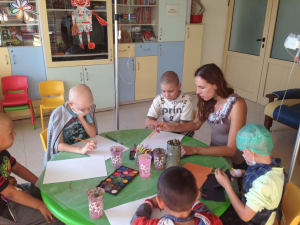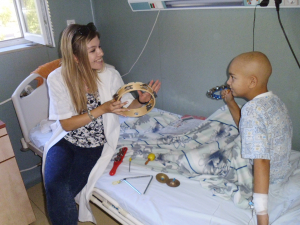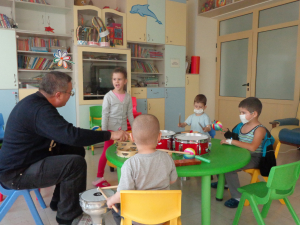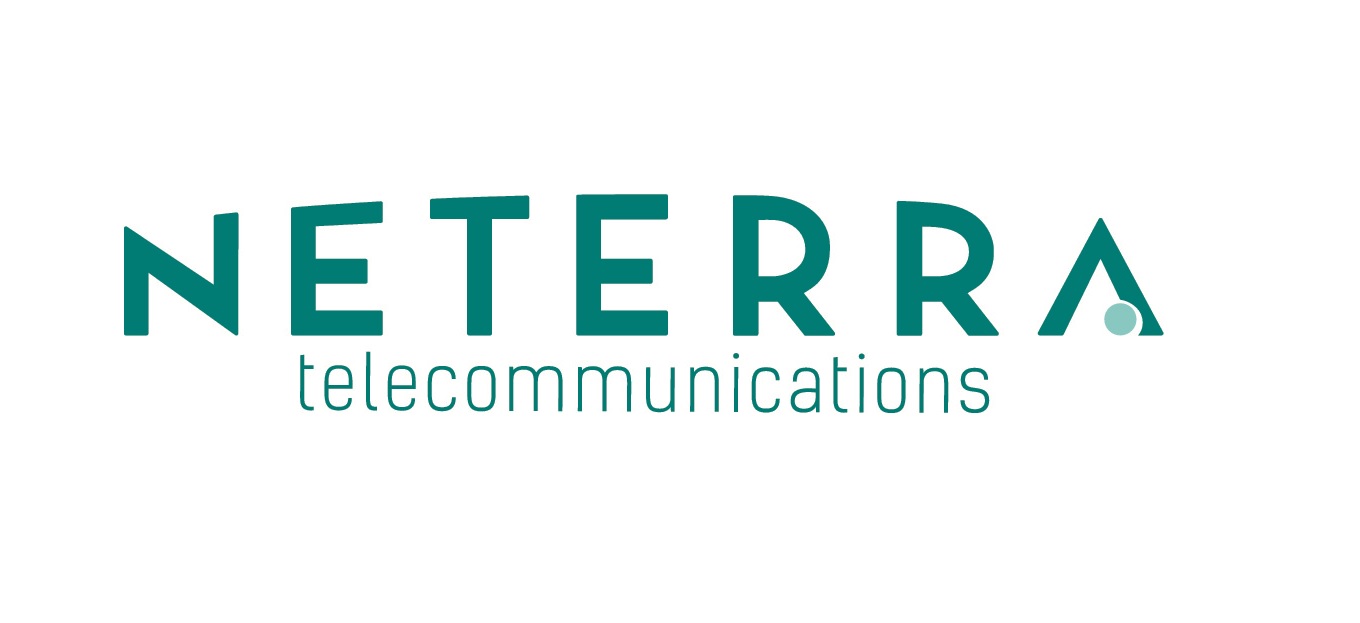
ARTON PROGRAM - The therapeutic power of the group
Creative projects involving group work - general musical performance or group painting, collage, sculpture - are useful in helping to explore and strengthen social...
In the ARTON Program our team of oncopsychologists, art therapists and music therapists develops the process of children's creativity as a process of self-knowledge, an opportunity for the child to see through a mirror his essence, his place in life and his role in his own healing. Creativity is the inner urge of each of us to live, to develop, to rejoice, to be happy. Art therapy gives us the opportunity to regain the impulse for creativity as a form of discovering the messages hidden in our soul. In the sessions conducted by our teams, the final product is not sought, but the happiness of the children patients in the very process of creation. Healing through creativity does not become a goal, but a need to look further through the forms of different arts. Art therapy in our sessions helps children to allow themselves to think "out of shape", to develop their imagination, their ability to wonder and rejoice, their spontaneity. In our work we use art to move our feelings as a way to calm down, have fun and so - to see ourselves.
The art therapy applied by our teams is a model of relaxing therapy, provoking the creativity inherent in every child and able to strengthen him, both emotionally and physically. In our clinical practice, art therapy includes creative activities of patients with fine arts, modeling with clay, application, decoration, music. In the situation of a life-threatening disease, art therapy is the form that brings calming, pacification, purification and mobilization to cope. The child patient rediscovers himself, learns to help himself in the fight against pain, depression or difficulties in interpersonal relationships. He finds ways to rethink his path and struggle along the path of spiritual creation, to direct his being in the positive direction of healing. With our many years of clinical work, we significantly recognize that art therapy can control certain disease symptoms, emotions and other difficulties during the healing process and help patients recover faster, both mentally and somatically.
The experience of psycho-emotional trauma becomes the center of the child's personality, memories, feelings, thoughts. The traumatic event has the power to affect and even construct the identity of the suffering person. The presentation or even hint of a traumatic event in the "products" of the imagination can reach much deeper levels of significance than in a simple recitation of the "facts" in standard conversational therapy. Once the arts gain access to the therapeutic space, it is no longer possible to remain in the literal space of reality. Instead of being seen as a defect in the therapeutic process, it is this necessary transformation in the imaginary reality that is its main virtue for our practice. Creation does not literally reproduce the event that caused suffering, but transforms and changes the facts through the imagination, separates the child from the reality of what is happening, distances his gaze, hence the sensations. In this way, together with him, we free ourselves from the grip of the traumatic event and have the opportunity to see it for the first time.
In our practice, it happens that children with cancer reveal in the art sessions behavior that, to a greater or lesser extent, is rigid mechanical movements of the body, which can be mistaken for stereotypical behavior. In developing art therapeutic interventions that reflect this end of the behavioral spectrum, the ARTON Program Therapist has in mind that these "stereotypes" may have a stress-reducing function for children undergoing a long and stressful healing process and isolation. Stereotypes here can often be seen as a form of self-regulatory behavior that gives rise to a form of homeostatic regulation. The methods of intervention in these cases require careful consideration by a specialist, as overstimulation can cause great distress to the already traumatized child. In our work, we also found a direct parallel between stereotypical behavior and the use of schematic drawing or the creation of repetitive creative elements by the traumatized child. The change in the situation, including the offered artistic tools, can change the affect of liveliness experienced by the children while presenting their rigid behavior, soften it, distract it, transform it.
In the sessions of the ARTON Program the main place is given to the creative game, which provides variety and opportunities to explore the unthinkable or what the child forbids to talk and even think about. The experience of emotional suffering, characteristic of our conditions and work, is accompanied by a sense of limitations of the situation and a sense of their own, individual inability of each child patient. Creativity with an art therapist in individual or group sessions on Programe ARTON facilitates the emergence and completion of the work of art, which in turn brings the cathartic feeling of peace and freedom of each patient who has taken the path of their own healing and development.

Creative projects involving group work - general musical performance or group painting, collage, sculpture - are useful in helping to explore and strengthen social...

In the ARTON Program our team of oncopsychologists, art therapists and music therapists develops the process of children's creativity as a process of...

In ARTON sessions, creating a piece of music or a song is an emotional experience of coping and satisfaction for the participating children. They make friends with...

Painting provides patients with a spontaneous, plastic method of depicting thoughts and experiences. Painting with paints is not as structured as with pencil or...










